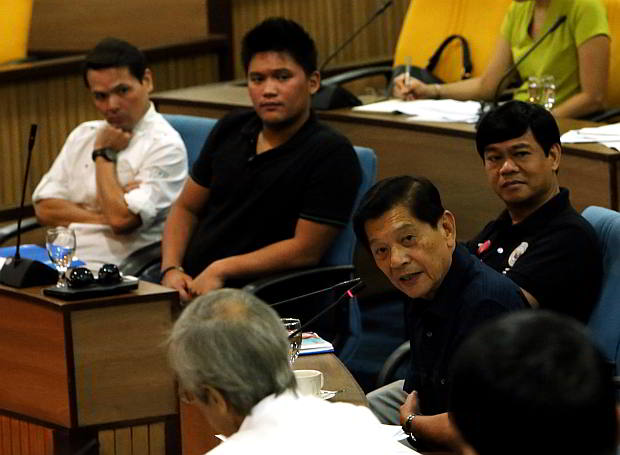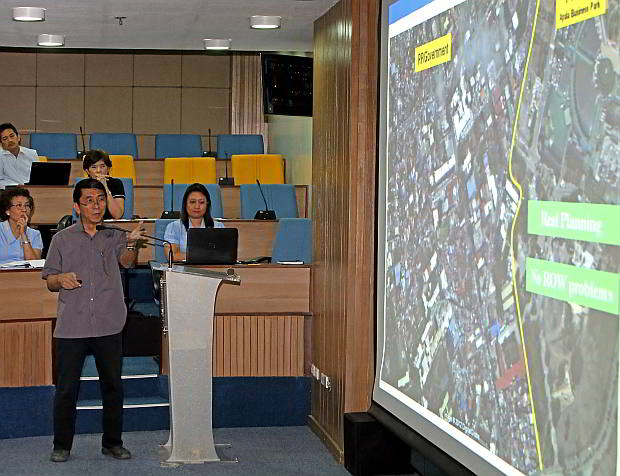Mega Cebu planners turn to congressmen
Faced with roadblocks in getting Cebu priority projects moving, Mega Cebu planners yesterday asked Cebu congressmen for help.
Only five of 46 projects identified as critical in order for Cebu to be “competitive” are assured of funding in 2015 by the Department of Public Works and Highways (DPWH).
Among the big-ticket items left out are master plans for traffic and drainage, flared intersections, the 3rd Cebu-Macan Bridge, and road widening in various sites.
“Without investments, we will lose out as we are doing at the moment,” said Roberto Aboitiz, co-chairman of the private sector-led Mega Cebu movement in a forum attended by congressmen of Cebu City, and the 1st and 5th districts.
The problem was described as the lack of “real planning” in government – lack of experts, inadequate consultation with local stakeholders, no master plan, and a slow bureaucracy that ties up road-right-of-way (RROW) acquisition in projects that could ease traffic.
The result, said Engr. Jun Sanchez, is a “failure of engineering” such that P150 million is lost daily in Metro Cebu due to traffic jams.
The congressmen can leverage more projects during budget sessions for passage of the the 2015 General Appropriations Act.
In enlisting their help, Aboitiz said he was placing at their disposal the Metro Cebu Development and Coordinating Board (MCDCB), a coalition formed in 2011 of private sector volunteers, mayors in seven towns and six cities of Metro Cebu, the Province of Cebu and national government agencies.
He said Cebu’s growth as a “region-city” or “cluster of cities” required a “mindset change” that gets everyone thinking as “Team Cebu” without getting bogged down in political geography.
“I want to ask our congressmen how can we assist them in championing the cause of the Cebuano in congress?” said Aboitiz who addressed Representatives Raul del Mar (Cebu City north district), Rodrigo Abellanosa (Cebu City south district), Gerald Anthony Gullas (1st district) and Joseph “Ace” Durano (5th district) who attended the briefing at the Eduardo Aboitiz Development Center.

Businessman Roberto Aboitiz (top right) makes his pitch to congressmen of Metro Cebu: (from left) Ace Durano (5th district) , Gerard Anthony “Samsam” Gullas (1st district), Rodrigo Abellanosa (Cebu City south district), and Raul del Mar (Cebu City north district) at the Eduardo Aboitiz Studies Development Center. (CDN PHOTO/ LITO M. TECSON)
Specifically, urban planners in the Mega Cebu movement asked congressmen to:
1. Lobby for President Aquino to issue an Executive Order to create a ROW acquisition body exclusively for Mega Cebu and allocate a bigger budget for it
2. Ask DPWH Secretary Ricardo Singson to revise performance indicators of how his district engineers and regional director in Mega Cebu are measured.
During the briefing, it was learned the performance of DPWH officials is based on how quickly they use their project budgets, instead of useful metrics like traffic rate and reduction of flood-prone areas.
Congressman Del Mar said he supports the vision of integrated development in Metro Cebu. He recalled that he filed the bill for a Metro Cebu Development Authority over 20 years ago and refiled it two more times but “there was no meeting of minds” among local legislators.
He said the MCDCB “is working very well” and “it’s better that it is a private initative.”
He agreed that congressmen and Mega Cebu leaders should coordinate better so that projects identified by both camps have better chance of getting funded.
“We have to face the reality that the pie is only so much. It’s hardly possible for your recommendation and ours to get more funding,” he said.
Del Mar suggested that the MCDCB, whose main secretariat is the Ramon Aboitiz Foundation Inc., should be the one to approach each congressmen to get their agreement before he refiles any bill for the creation of a Metro Cebu Development Authority.
Congressman Durano said he noticed that the list of Mega Cebu project was mostly listed as having “no funds” in the DPWH.
He suggested that time was being wasted, after the lengthy process of getting approval of the Regional Development Council and consulting the DPWH regional office, because the real budget process starts with the district engineers.
In his presentation, Engineer Sanchez said that Cebu City’s rank from among the 500 most livable cities in he world dropped by 10 slots. Cebu now occupies the 475th in a survey of 500 cities because of corruption, inefficiency in government bureaucracy and inadequate infrastructure.

Engr. Jun Sanchez shows the urban congestion in Metro Cebu. This can be solved through proper planning, he says. (CDN PHOTO/ LITO TECSON)
Mega Cebu covers Carcar City in the south to Danao City in the north, including Mactan island. Cebu’s population of almost 4 million has about 2.3 million concentrated in this urban metropolis.
Engr. Arnold Fabular reported that out of 46 proposed projects submitted to DPWH for funding, only 13 were partially funded and five were “fully funded” in 2014 and 2015.
The five are:
*Hernan Cortes Street, Mandaue City (widening, ROW, sidewalk, drainage (P300M);
*A.S. Fortuna Street, Mandaue for Flood control and drainage (P100M);
*Cebu South Road (Naga to Carcar) for Widening, concreting (P50M);
*Cebu South Road (Kinasang-an to Bulacao, Cebu City) Widening, ROW (P200M); and
* C. Padilla Street (Abella to SRP Access road) for widening, ROW (P210M).
ROW problems take five to 10 years to resolve, dealying road projects, he said.
If only Cebu City have wider roads,the implementation of the Bus Rapid Transit (BRT) system here will not be a problem, Sanchez said.
Sanchez said that when the Metro Cebu Development Project (MCDP) was disbanded, this also resulted to “wastage” of projects that could have been implemented by now.
Sanchez said there is now a need to revive an earlier plan to create the Metro Cebu Development Authority (MCDA) to integrate designs and oversee the implementation of development projects here.
The bill has been pending in the House of Congress since 2004.
In emphasizing the need for a drainage masterplan, he said that in 1983 alone, 18 areas were identified as floodprone in Metro Cebu area.
In 2006, this increased to 126 areas in Cebu City alone.
Disclaimer: The comments uploaded on this site do not necessarily represent or reflect the views of management and owner of Cebudailynews. We reserve the right to exclude comments that we deem to be inconsistent with our editorial standards.





